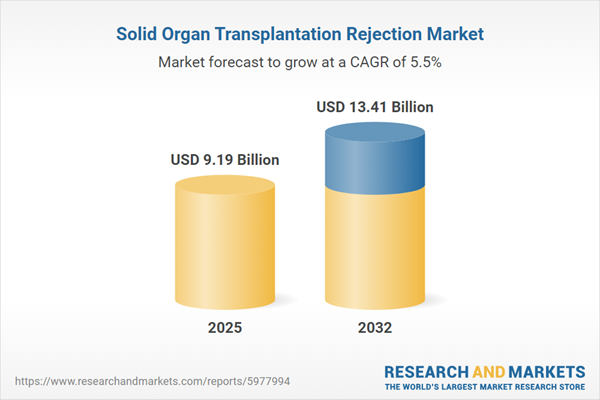Speak directly to the analyst to clarify any post sales queries you may have.
The solid organ transplant rejection market is evolving rapidly, shaped by technological innovation, shifting regulatory frameworks, and increasing global demand for advanced patient management solutions. Senior decision-makers face a landscape defined by clinical, operational, and economic complexity, requiring strategic insight into market segmentation, emerging therapies, and critical policy influences to support effective investment and partnership decisions.
Market Snapshot: Solid Organ Transplant Rejection Market Growth
The solid organ transplant rejection market grew from USD 8.74 billion in 2024 to USD 9.19 billion in 2025, signaling robust expansion. This market is projected to maintain a steady 5.50% CAGR, reaching USD 13.41 billion by 2032.
Market growth is underpinned by advancements in molecular diagnostics, precision immunosuppression approaches, and the rising adoption of personalized patient care pathways in transplantation. These dynamics reflect increased investments from global biopharmaceutical and medtech companies, alongside more integrated clinical and regulatory collaboration worldwide.Scope & Segmentation: Deepening Market Insights
- Rejection Type: Acute rejection, chronic rejection, and hyperacute rejection remain key drivers influencing therapy choice and diagnostic monitoring.
- Offering: The market covers diagnosis and testing solutions (blood tests, imaging tests, tissue biopsy) as well as medication portfolios encompassing antibodies, antimetabolites, calcineurin inhibitors, and steroids.
- Type of Organ Transplant: Heart, kidney, liver, lung, and pancreas transplantation segments each present unique immunologic challenges and have distinct monitoring and follow-up protocols.
- End User: Market end users include hospitals and transplant centers, research institutes, and specialty clinics, each with specific resource requirements and integration needs.
- Regions: Coverage spans the Americas (United States, Canada, Mexico, Brazil, Argentina, Chile, Colombia, Peru), Europe, Middle East & Africa (including major economies such as the United Kingdom, Germany, France, and emerging hubs in the Middle East and Africa), and Asia-Pacific (China, India, Japan, Australia, South Korea, Indonesia, Thailand, Malaysia, Singapore, Taiwan).
- Companies: Featured players include Abbott Laboratories, Accord Healthcare Limited, Asahi Kasei Corporation, Astellas Pharma Inc., Biocon, Cipla Ltd., Dr. Reddy's Laboratories Ltd., Eurofins Transplant Diagnostics, F. Hoffmann-La Roche Ltd., GlaxoSmithKline PLC, Globela Pharma, Lupin Limited, Manus Aktteva Biopharma LLP, Natco Pharma Ltd., Novartis AG, Panacea Biotec Pharma Ltd., Pfizer Inc., Plexision, Sanofi S.A., Strides Pharma Global Pte Ltd., Thermo Fisher Scientific Inc., Veloxis Pharmaceuticals A/S, and Zydus Lifesciences Limited.
Key Takeaways for Decision-Makers
- Early adoption of digital health tools and precision immunosuppression is accelerating shifts toward patient-specific management and real-time risk stratification.
- Personalized diagnostics, multi-omic data integration, and biomarker-driven monitoring are influencing the development of next-generation rejection therapies.
- Regional differences in regulatory pathways and reimbursement policies drive variable technology uptake and necessitate tailored go-to-market approaches across global territories.
- Strategic industry collaborations support faster validation and commercialization of novel testing platforms and therapeutic modalities.
- Emphasis on remote patient monitoring and telehealth integration is enhancing post-transplant surveillance and engagement in both high-resource and decentralized settings.
Tariff Impact: United States Policies and Market Dynamics
New United States tariff policies in 2025 are leading to increased costs for critical reagents, diagnostic kits, and immunosuppressants. This is prompting procurement teams to adjust sourcing strategies, explore regional production, and potentially delay investment in new technologies. Industry and policymakers are collaborating to safeguard equitable access and minimize disruptions in clinical innovation and supply chains.
Methodology & Data Sources
This report leverages a comprehensive research framework built on in-depth interviews with clinicians, laboratory leaders, and procurement experts, coupled with systematic analysis of peer-reviewed journals, regulatory filings, and industry white papers. Data were cross-referenced with real-world evidence and further refined through expert validation sessions and advanced scenario modeling.
Solid Organ Transplant Rejection Market: Why This Report Matters
- Gain clear, actionable insights into evolving technology adoption, market segmentation, and investment opportunities in solid organ transplant rejection.
- Understand how shifting regulatory frameworks, tariff impacts, and patient care models are altering the competitive landscape and shaping product development priorities.
- Leverage trusted data and expert analysis to inform strategic planning, risk mitigation, and partnership decisions across global markets.
Conclusion
The solid organ transplant rejection market is undergoing profound change driven by technology, collaboration, and policy. By applying these research insights, leaders can build adaptive, data-driven strategies for improved patient care and sustained market advantage.
Additional Product Information:
- Purchase of this report includes 1 year online access with quarterly updates.
- This report can be updated on request. Please contact our Customer Experience team using the Ask a Question widget on our website.
Table of Contents
3. Executive Summary
4. Market Overview
7. Cumulative Impact of Artificial Intelligence 2025
Companies Mentioned
The companies profiled in this Solid Organ Transplantation Rejection market report include:- Abbott Laboratories
- Accord Healthcare Limited
- Asahi Kasei Corporation
- Astellas Pharma Inc.
- Biocon
- Cipla Ltd.
- Dr. Reddy’s Laboratories Ltd.
- Eurofins Transplant Diagnostics
- F. Hoffmann-La Roche Ltd.
- GlaxoSmithKline PLC
- Globela Pharma
- Lupin Limited
- Manus Aktteva Biopharma LLP
- Natco Pharma Ltd.
- Novartis AG
- Panacea Biotec Pharma Ltd.
- Pfizer Inc.
- Plexision
- Sanofi S.A.
- Strides Pharma Global Pte Ltd.
- Thermo Fisher Scientific Inc.
- Veloxis Pharmaceuticals A/S
- Zydus Lifesciences Limited
Table Information
| Report Attribute | Details |
|---|---|
| No. of Pages | 180 |
| Published | November 2025 |
| Forecast Period | 2025 - 2032 |
| Estimated Market Value ( USD | $ 9.19 Billion |
| Forecasted Market Value ( USD | $ 13.41 Billion |
| Compound Annual Growth Rate | 5.5% |
| Regions Covered | Global |
| No. of Companies Mentioned | 24 |









